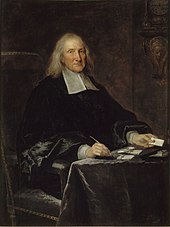Toussaint Rose
Toussaint Rose (born September 3, 1611 or baptized on September 5, 1615 in Provins , today's department of Seine-et-Marne ; † January 6, 1701 in Paris ) was a French secretary of Cardinal Jules Mazarin (1602-1661) and worked as whose partisans at the court of King Louis XIV.
Life
Rose was born in 1611 or 1615, the sources disagree, but the date 1615 speaks more, as the biographer Villiers du Terrage claims to have viewed the baptismal certificate in the Provins city archives.
Rose attended a Catholic seminary ( école des prêtres séculiers ) in Provins. He later obtained a law degree in secular and canon law from the Sorbonne in Paris. He then returned to Provins and worked there as a lawyer for two years .
On November 26, 1636 he was sworn in as a lawyer at the Parlement in Paris. He decided to enter the service of Cardinal Armand-Jean du Plessis, duc de Richelieu (1585–1642). He gave up this post in March 1638 and joined the entourage of Jean-François Paul de Gondi (1613–1679), with whom he went to Italy .
Mazarin's secretary
Upon his return from Italy, Rose joined Jules Mazarin. Rose married Madeleine de Villiers on September 8, 1641 († June 27, 1701). Rose rented a house in Suresnes (he later bought a house there). Louis Rose, his only child, was born there on August 31, 1642. When Cardinal Richelieu died on December 4, 1642, Mazarin was replaced by Principal Ministre de l'État (comparable to a Prime Minister ).
In 1643 the system of members of the Conseil du roi de France (adviser to the King of France) was reformed. This reformed body was the forerunner of today's Council of Ministers in France . In December 1645 Rose was named "Secretary of His Eminence" (Mazarin's secretary). Due to the influence of Mazarin Rose was accepted on October 30, 1649 in the Conseil du roi de France by Anna of Austria (1601–1666).
During the time of the Fronde (1648–1653) Rose traveled a lot as Mazarin's messenger between Mazarin and Louis II. De Bourbon, prince de Condé , (1621–1686) and Jean-François Paul de Gondi. Even during the time when Mazarin was in exile (1651-1653), Rose continued to work for him.
From 1654 Rose was responsible for supervising and managing the forestry of Philippe I. de Bourbon, duc d'Orléans , the king's brother.
In 1655 Toussaint Rose and his father Étienne Rose were raised to the nobility. Étienne Rose had meanwhile become mayor of Provins, he chose a blue coat of arms with a gold chevron (inverted V) and three roses, two of them next to each other at the top ( en chef ) and one at the top. The coat of arms was held by two greyhounds and the motto was: "Nunquam marcessent" (never wither). Shortly afterwards, Toussaint Rose acquired the Coye fiefdom in the Chantilly forest and called himself Marquis de Coye.
Secretary to the King
On April 25, 1657 Rose was appointed Secretary of the King's Chamber ( secrétaire de la chambre et du cabinet de Sa Majesté ) and in 1661 President of the Court of Auditors in Paris. In 1667 he achieved that the members of the Académie française were socially of the same rank as the members of the Parlement. For this he was accepted into the Académie française in 1675 as the successor to the writer Valentin Conrart ( armchair 2 ). He was followed by the lawyer Louis de Sacy after his death .
literature
- Paul Mesnard: Histoire de l'Académie française depuis sa fondation jusqu'en 1830 . Charpentier, Paris 1857.
- Marc de Villiers du Terrage: Un secrétaire de Louis XIV: Toussaint Rose, marquis de Coye, président de la Chambre des comptes . May et Motteroz, 1891. in archive.org (French)
Web links
- Short biography and list of works of the Académie française (French)
Individual evidence
- ↑ a b Académie française Les Immortels ( Memento of the original dated June 12, 2010 in the Internet Archive ) Info: The archive link was automatically inserted and not yet checked. Please check the original and archive link according to the instructions and then remove this notice. , based on: Émile Gassier: Les cinq cents immortels. Histoire de l'Académie française 1634-1906 . Jouve, 1906. (French)
- ↑ Villiers du Terrage p. 7 and baptismal certificate as Appendix 2 p. 118
| personal data | |
|---|---|
| SURNAME | Rose, Toussaint |
| BRIEF DESCRIPTION | French court official |
| DATE OF BIRTH | September 3, 1611 |
| PLACE OF BIRTH | Provins |
| DATE OF DEATH | January 6, 1701 |
| Place of death | Paris |
